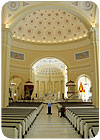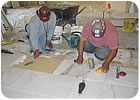
The Basilica of the National Shrine of the Assumption of the Blessed Virgin Mary in Baltimore, MD, has a long and storied past. As the first metropolitan cathedral and major religious building that was constructed in America after the adoption of the Constitution, it became a symbol of religious freedom that was a core to the newly formed U.S., when its cornerstone was laid in July 1806. Since that time, the structure has stood tall with an exterior built of a combination of Acquia Creek sandstone from Virginia and gneiss - a bluish-gray granitic stone that was quarried in Elliott City, a 20 minute drive west of the Basilica site. But due to wear and tear over the years, the Basilica was in need of a repair and restoration, which included creating an interior marble floor that had been specified in the structure’s initial design - but never implemented.
The original design was the work of the architect Benjamin Henry Latrobe, who was considered the “father of American architecture” and was the Surveyor of Public Buildings - the predecessor title of the Architect of the U.S. Capitol - under President Thomas Jefferson. Latrobe worked closely with John Carroll - the country’s first bishop and later Archbishop of Baltimore, and cousin of Charles Carroll, who signed the Declaration of Independence. Latrobe’s design for the Basilica is considered to be his best, most refined work, a reflection of his inspiration through routine correspondence with President Thomas Jefferson on matters of architecture. It has been said that, “Their collaboration produced a building that in its day rivaled the Capitol in size, scale and architectural sophistication.”
At the time, Carroll’s original vision of a cathedral adopted the forward-looking neoclassical architecture of the new federal city in Washington. He desired an architectural symbol that was not Gothic, which was reminiscent of the Dark Ages in Europe. When Latrobe learned of Carroll’s project, he volunteered his architectural services. The most distinguishable part of Latrobe’s design is its grand dome and 24 skylights, which produced a diffused light.
John G. Waite Associates of Albany, NY, a firm specializing in historic preservation, and noted historic preservation contractor Henry H. Lewis of Owings Mills, MD, were contracted for the restoration project. Work on the Basilica began in November 2004, and it took two and a half years to complete the construction phase of the restoration.
According to Steve Reilly of John G. Waite Associates, this work was part of a larger restoration project. “It is the oldest Catholic Cathedral in the U.S.,” he said. “In 1998, the Basilica of the Assumption Historic Trust hired us to do an historic structural report; then they received additional funding from the Getty Grant for a further investigation into the building’s fabric.
“This accumulated into a formative way of developing construction documents,” Reilly went on to explain. “We weren’t approaching it the way that is most recognizable, by taking the building back to an absolute fixed point in history. Instead, we restored it to a particular vision of the original architect. This makes the restoration a bit unusual because of that.”
The architect explained that the building was constructed over a relatively prolonged period of time. “The original design was started in 1806, and it was dedicated in 1821,” he said. “Latrobe died nearly the same time that it was dedicated. It wasn’t complete by any stretch.”
Reilly went on to say that because of insufficient funds, a lot of the design was never originally completed. “They had to use wood and brick to complete the interior floors, but noted that marble [was supposed] to be used,” he said. “Latrobe and Carroll’s intentions were followed very closely up until about the Civil War. With the exception of the sanctuary addition in 1890, the design intent for the interior started to get lost. Finishes were changed, and over the years, Bishops had changed the interior because they wanted it to look a certain way, irrespective of the original intent.”
One of the more dramatic changes came in the 1940s, when stained glass windows replaced the translucent windows that had been in place for 50 years, according to Reilly. “The whole original design thrived on the balance of light and space,” said the architect. “With respect to the subsequent redecorations of the interior, it literally just felt dull and flat - part of the restoration was to bring those [translucent] windows back. It’s astounding the difference in lighting [they create]. The original paint scheme was also reinstated. It’s a vast transformation from what it was from the last campaign in the 1960s.”
Additionally, the interior restoration involved replacing the floor with Colorado Yule marble, which was quarried by Polycor Colorado Stone Quarries in Marble, CO, and cut into pavers by Georgia Marble Co. of Kennesaw, GA. The Basilica’s original drawings illustrate that a light-colored marble floor was intended. The original wood and brick floor had been later followed by dark-colored marble. To allow the addition of modern heating and air conditioning systems as part of the restoration, the dark marble was removed and replaced with the white marble, which features gold, gray and black veining.

Restoring the exterior
“On the whole, the building was designed and built - and survived - very well,” said Reilly. “Specific to the stonework, the deterioration was the result of cleaning campaigns. Sandblasting brick and stone is like etching enamel from teeth. It takes the resilience out of a building. The gneiss, which is most of the exterior of the building, is very hard and resilient, and it held up fairly well despite the past cleaning. It’s a metamorphic stone - a variation of granite.”In total, there was 45,000 square feet of stone walls, which needed to be restored to their original appearance. As a result of the previous sandblasting cleanings, the gneiss and its joints were pitted and pocked.
Coastal Exteriors in Cockeysville, MD, completed the exterior restoration work. Ted Wolf, company president, and his crew began the process by soaking the stone with clean water first. They then brushed on Sure Klean® Light Duty Restoration Cleaner from ProSoCo Inc. of Lawrence, KS. After letting the cleaner set for five to 15 minutes - depending on how dirty each stone piece was - the dissolved contaminants and spent cleaner were pressure-rinsed away.
“Apparently, sandblasting was done in the early 1960s,” said Wolf. “There was only 40 years of pollution, so it wasn’t overly dirty. The condition of the stone was rough and heavily pitted though.”
Once the walls were clean, the crew cut out the old joints. They had a different profile from the original grapevine joints, as a result of repairs over the years, according to Wolf.
Chipped and deteriorated stone edges made it a challenge to get clean joints. “Probably one of the harder aspects of the project was that the corners were pretty deteriorated,” explained Wolf. “It was challenging getting that reveal. We had to be careful and precise to get nice clean tooling.”
The crew then used slicker tools to fill and tool the joints with the original type of mortar - restoring the original profile and close to 90% of the exterior’s original appearance. Once the process was finished, Wolf and his crew - consisting of about eight workers - used ProSoCo’s Sure Klean® 600 Detergent to remove construction soiling and small amounts of excess mortar. Kenseal Construction Products of Baltimore supplied both the 600 Detergent and Light Duty Restoration Cleaner.
In total, it took about six months to complete the exterior stone restoration, according to Wolf. “We completed approximately 750 patches,” he said, adding that Jahn Stone Restoration mortars were used for the job.
According to Reilly, there was also a portico added according to Latrobe’s original design in the 1860s, which was comprised of New Brunswick freestone from Canada. “[Originally], the facade of the building was built with Acquia Creek sandstone piers and panels,” said the architect. “Before the construction of the portico, written accounts describe that the structure was damaged due to softness, so they switched the stone specification from Acquia Creek to New Brunswick freestone. And over time, the stone changed colors and went through campaigns of cleaning and staining and paint. It was finally cleaned once again and re-stained to get back to what it used to be.”
For the exterior paving at the portico, slate and Colorado Yule marble tiles were used in an alternating checkerboard pattern. The stone was cut and honed at Georgia Marble’s facility and then shipped to the site to be installed, according to Reilly.
